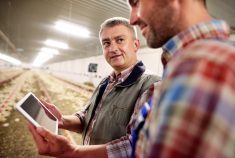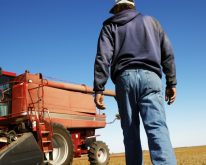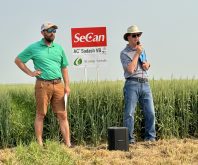For farmers like Shelley McPhail, there’s a big return on selecting the best business-education programs for your farm, and the best grants to help analyze your farm busness
Shelley McPhail’s eyes sparkle. She is telling me about the work she does encouraging farmers to sign up for professional development courses and to apply for grants, and her energy and emotion are there right at the surface, open for all to see. And that should come as no surprise for, as I quickly learn, McPhail herself is a walking advertisement for how these programs can transform not only our farm businesses, but the people who run them.
That is, if the right farmer gets lined up with the right program, which based on McPhail’s experience, probably isn’t as difficult as it might sound.
Read Also

Riding the tariff rollercoaster
Farmers are accustomed to roller-coaster years. But the current geopolitical windstorm is something else entirely. On his cattle operation near…
McPhail farms part-time with her husband Harold on 450 acres near Almonte, Ont. in the Ottawa Valley. She’s also a workshop leader and program representative for Growing Forward’s Business Development, administered in Ontario through the Ontario Soil and Crop Improvement Association (www.ontariosoilcrop.org/workshops).
As both a farmer and facilitator, McPhail’s own training — including her MBA — are vital to her work, helping her set targets and then achieve them, whether for herself or for others.
But it works as well as it does because McPhail, like other farmers, is able to integrate that training with her wealth of insights gleaned from being a part of a farm community, immersed in farm culture.
Every farm has at least one pivotal moment, McPhail tells me. Sometimes that fulcrum is tragic, personal and emotional. For the McPhails it was an early winter morning in 2000. Harold and Shelley were in the barn milking their 40-cow dairy herd while their two pre-teen children were still snuggled in their beds.
Fire broke out and started racing through the bungalow.
Luckily, the McPhail children knew some fire safety and they escaped through their bedroom windows, but Shelley couldn’t shake the connection between milking the cows and the near loss of her children, with the complete destruction of the family home.
Two years later, the McPhails sold their cows and quota, bought a few beef cows and continued their cropping operation. Harold started driving truck in the winters and Shelley took charge in the barn, but she was looking for more.
In January 2005, now in her mid-40s with a diploma in business administration, Shelley applied for the University of Guelph’s Masters in Business Administration in Agriculture, a mostly online course with some short residency requirements. “I needed to move myself forward,” she says.
The program begins annually in May, can be completed in two years and today costs $42,000 (www.uoguelph.ca/cme/mba). When McPhail enrolled, it started in June, took three years and cost about $30,000.
The MBA was also heavily loaded with group work with people from multiple time zones, resulting in some late-evening online time for McPhail. Her thesis though was a strategic analysis of her own farm, including linear programs to test various enterprises, and it was an eye-opener.
But the main immediate impact was in her, not the farm. Beyond business know-how, the MBA experience also helped McPhail develop both her self esteem and her ability to draw the positive out of people. Those might be what are called soft skills, but she has used them many times in her role as workshop leader. “A positive attitude is contagious,” she says. “People start feeding off each other.”
But it goes beyond that too. McPhail even says a good attitude is also key to getting the most out of the government-supported programs. “The money is available, you might as well use it,” she says. “It’s there for a reason. The government is responding to a demonstrated need.”
“The better you are prepared, the easier it is to take advantage of some of these programs,” adds Cliff Harrison, a business consultant for Prairie Skies AG Consulting in Domain, Man. and who has been advising farmers for 40 years.
In Harrison’s experience, the farmers with the best track records of getting into these programs are farmers who consistently complete their year-ends on a timely basis and then scope out the coming the year. “If you’ve already done your homework, know your historical needs and have a focus on the future, it’s easier to take advantage of these grants,” says Harrison.
Government business years typically go from April 1 to March 31, so both federal and provincially funded programs tend to be initiated then. For example, the existing five-year Growing Forward Agreement will expire next March and the next Growing Forward Agreement is being developed to replace it then.
For farmers, that means their annual financial farm books should be done by mid-February to take advantage of the programs before the ramp up to the next government year.
It also means doing the legwork to know which programs — and what details — apply in your province and to your farm. Although many companies sell the service of finding and applying for grants, the Canadian government’s (www.canadabusiness.ca) online search service is free. All the provinces and the territory of Yukon have information on their websites about their agriculture grants. Also, Farm Management Canada has a detailed listing of support programs for farmers with links at www.farmcentre.com/features/thenewfarmer/Resources/GrantsAndPrograms.aspx.
Workshops
Across the country, funding is often available only after farmers participate in a course, seminar or workshop. McPhail has seen this format work exceptionally well, from both sides of the desk.
She leads two-day Growing Your Farm Profits workshops in Ontario and within a week of the sessions she meets again with participants to review their action plans and forms. Then the farmer completes a cost-share application and mails it off to OSCIA for approval and then payment.
“The workshop leaders walk you through it,” says McPhail. “They give you a checklist and help ensure you fill out everything correctly.”
Each province and territory determines the type of management and skills development training it will offer and how it will be delivered in the Growing Forward’s business-development programs. Ontario is the only place where the program isn’t being delivered through the minister of agriculture.
What you can get funding for and how much funding you can get also varies geographically. In 2009, the McPhails took advantage of the subsidized full-farm financial assessment. In Ontario, grants for $2,400 go toward hiring a farm financial planner to analyze your farm finances and then come back a year later and review developments. Farmers only pay $100.
The financial adviser drove up their lane and viewed their operation and their plans with fresh eyes. “It was the best thing we’d ever done for our farm,” says McPhail. “He gave us objective ideas.”
They had been thinking about starting an on-farm brewery but the adviser could clearly see their personal and farm’s strengths and weaknesses. Instead, he suggested that since Harold already enjoyed driving truck for someone else, he should buy his own rig. The McPhails did that and bought a bigger sprayer and Harold got his commercial pesticide-application licence to do some custom spraying.
“Planning is everything but, sometimes circumstances force a revision of the plan,” says Shelley.
Be prepared
For many government programs, funding is limited and oversubscribed. For example, the demand for project funding through the Environmental Farm Plans means the application deadlines are notoriously frantic. Under the EFP, funding is limited by announcements per year and demand is high for a limited number of dollars. In Ontario, farmers take a workshop in advance, fill out the binder with the help of course leaders and line up on a given day as funding is limited to the first come, first serve basis or by the end of the year.
Under the EFP program, the need to be absolutely prepared is even more pressing, says McPhail. For their farm, she applied and got grant money to help buy a no-till drill with GPS, as well as fencing to keep their cattle out of the river running through the farm. She says it paid to have a plan complete with quotes when she walked through the door on application day.
McPhail says that for some programs it’s important to make it work around the farm’s schedule. This is especially true for the workshops she leads which involve committing two full days and some time-consuming planning and communication. For most farmers, participating in these workshops is usually best done in late fall or early winter, she says. “Do the workshop at a time when you can keep the momentum going,” she advises.
Communicate
Both McPhail and Harrison suggest communicating with the field staff, key extension people and your accountant about these grants to prioritize the programs you want to get into and to get the forms filled out the way the programs’ administrators want them. Some of the local folks administering these programs have been known to keep farmers posted on the dates and life of the program, and let them know when new programs are being planned and what other grants are available.
“Only a select group are going to fit into the program so you need to be aware well in advance what the funding is available, what the deadlines are and the requirements,” says Harrison.
Often in agriculture, applications are reviewed by a peer group who are given score cards and charts. In the past, Harrison has been on a peer group and has seen the importance of being specific and practical on applications forms. “They only have a couple of minutes to get a basic understanding of how significant it will be to meeting the goals of the farm,” he says.
If the applications are filled out based on hard financial records, real quotes and a predetermined business plan, it quickly tells the peer-review committee how well the application fits into the context of the program.
When Harrison applies for funding for farmer clients, he keeps in mind the mandate of the program and the current associated buzz-words, such as “renewable” or “sustainable.” Typically they start filling in the forms and then stop to ask him what do they really want me to say?
Harrison replies that once you focus on what your farm wants and needs and how that fits into the program, the application process often falls into place quickly. The projects are getting more capitalized and the pot of money is getting smaller, so it makes more sense to give the money to a handful of farmers that will complete the project timely and convert into something useful.
“There’s not much magic to it, anyone can do it,” says Harrison. “But you need to be disciplined, do a year-end review and update for the next year.” CG














